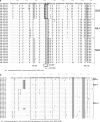Emerging genotypes of human respiratory syncytial virus subgroup A among patients in Japan
- PMID: 19553576
- PMCID: PMC2725673
- DOI: 10.1128/JCM.00115-09
Emerging genotypes of human respiratory syncytial virus subgroup A among patients in Japan
Abstract
Human respiratory syncytial virus (HRSV) is a common etiological agent of acute lower respiratory tract disease in infants. We report the molecular epidemiology of HRSV in Niigata, Japan, over six successive seasons (from 2001 to 2007) and the emerging genotypes of HRSV subgroup A (HRSV-A) strains. A total of 488 HRSV samples were obtained from 1,103 screened cases in a pediatric clinic in Niigata. According to the phylogenetic analysis, among the PCR-positive samples, 338 HRSV-A strains clustered into the previously reported genotypes GA5 and GA7 and two novel genotypes, NA1 and NA2, which were genetically close to GA2 strains. One hundred fifty HRSV-B strains clustered into three genotypes, namely, GB3, SAB3, and BA, which has a 60-nucleotide insertion in the second hypervariable region of the G protein. The NA1 strains emerged first, in the 2004-2005 season, and subsequently, the NA2 strain emerged in the 2005-2006 season. Both strains caused large epidemics in the 2005-2006 and 2006-2007 seasons. The average age of children who were infected with NA2 strains was significantly higher than that of those infected with GA5 and the frequency of reinfection by NA2 was the highest among all genotypes, suggesting that this genotype possessed new antigenicity for evading past host immunity. This is the first paper to show a possible correlation between an emerging genotype, NA2, and large outbreaks of HRSV in Japan. Continuing studies to follow up the genetic changes and to clarify the mechanism of reinfection in HRSV are important steps to understand HRSV infections.
Figures



Similar articles
-
High frequency of repeated infections due to emerging genotypes of human respiratory syncytial viruses among children during eight successive epidemic seasons in Japan.J Clin Microbiol. 2011 Mar;49(3):1034-40. doi: 10.1128/JCM.02132-10. Epub 2010 Dec 22. J Clin Microbiol. 2011. PMID: 21177891 Free PMC article.
-
Prevalence of respiratory syncytial virus group B genotype BA-IV strains among children with acute respiratory tract infection in Kolkata, Eastern India.J Clin Virol. 2009 Aug;45(4):358-61. doi: 10.1016/j.jcv.2009.05.013. Epub 2009 Jun 30. J Clin Virol. 2009. PMID: 19570709
-
Molecular epidemiology of human respiratory syncytial virus over three consecutive seasons in Latvia.J Med Virol. 2014 Nov;86(11):1971-82. doi: 10.1002/jmv.23855. Epub 2013 Dec 2. J Med Virol. 2014. PMID: 24301088
-
[Clinical research progress of human respiratory syncytial virus vaccine].Zhonghua Yu Fang Yi Xue Za Zhi. 2023 Jan 6;57(1):70-77. doi: 10.3760/cma.j.cn112150-20220822-00831. Zhonghua Yu Fang Yi Xue Za Zhi. 2023. PMID: 36655261 Review. Chinese.
-
Current and emerging pharmacological treatments for respiratory syncytial virus infection in high-risk infants.Expert Opin Pharmacother. 2023 May-Aug;24(10):1143-1158. doi: 10.1080/14656566.2023.2213433. Epub 2023 May 16. Expert Opin Pharmacother. 2023. PMID: 37165859 Review.
Cited by
-
Epidemiology and genetic diversity of human respiratory syncytial virus in Belgium between 2011 and 2019.Virol J. 2024 Oct 28;21(1):270. doi: 10.1186/s12985-024-02542-4. Virol J. 2024. PMID: 39468663 Free PMC article.
-
Phylodynamics and dispersal of HRSV entails its permanence in the general population in between yearly outbreaks in children.PLoS One. 2012;7(10):e41953. doi: 10.1371/journal.pone.0041953. Epub 2012 Oct 15. PLoS One. 2012. PMID: 23077477 Free PMC article.
-
Prevalence and clinical characteristics of human respiratory syncytial virus in Chinese adults with acute respiratory tract infection.J Med Virol. 2013 Feb;85(2):348-53. doi: 10.1002/jmv.23467. Epub 2012 Nov 28. J Med Virol. 2013. PMID: 23192884 Free PMC article.
-
Ten years of global evolution of the human respiratory syncytial virus BA genotype with a 60-nucleotide duplication in the G protein gene.J Virol. 2010 Aug;84(15):7500-12. doi: 10.1128/JVI.00345-10. Epub 2010 May 26. J Virol. 2010. PMID: 20504933 Free PMC article.
-
Gradual replacement of all previously circulating respiratory syncytial virus A strain with the novel ON1 genotype in Lanzhou from 2010 to 2017.Medicine (Baltimore). 2019 May;98(19):e15542. doi: 10.1097/MD.0000000000015542. Medicine (Baltimore). 2019. PMID: 31083208 Free PMC article.
References
-
- Anderson, L. J., J. C. Hierholzer, C. Tsou, R. M. Hendry, B. F. Fernie, Y. Stone, and K. McIntosh. 1985. Antigenic characterization of respiratory syncytial virus strains with monoclonal antibodies. J. Infect. Dis. 151626-633. - PubMed
-
- Cane, P. A. 1997. Analysis of linear epitopes recognised by the primary human antibody response to a variable region of the attachment (G) protein of respiratory syncytial virus. J. Med. Virol. 51297-304. - PubMed
-
- Cane, P. A. 2001. Molecular epidemiology of respiratory syncytial virus. Rev. Med. Virol. 11103-116. - PubMed
-
- Coates, H. V., D. W. Alling, and R. M. Chanock. 1966. An antigenic analysis of respiratory syncytial virus isolates by a plaque reduction neutralization test. Am. J. Epidemiol. 83299-313. - PubMed
MeSH terms
Substances
Associated data
- Actions
- Actions
- Actions
- Actions
- Actions
LinkOut - more resources
Full Text Sources
Medical
Miscellaneous

